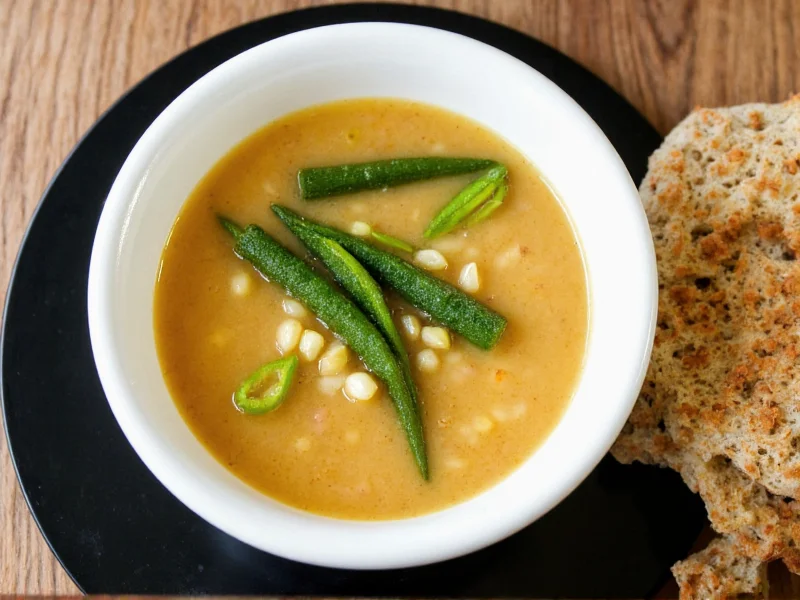Okra's unique mucilaginous properties make it a prized thickening agent in global cuisines, particularly in West African, Southern American, and Caribbean cooking traditions. This versatile vegetable contains soluble fibers that release a gel-like substance when heated, creating luxurious textures in soups and stews without requiring flour or cornstarch. Understanding the science behind okra's behavior transforms this often-misunderstood ingredient into a culinary asset.
The Science Behind Okra's Thickening Power
Okra pods contain polysaccharides and pectin that create viscosity when exposed to heat and moisture. These natural gums begin releasing at approximately 160°F (71°C), reaching maximum thickening potential around 185°F (85°C). Unlike artificial thickeners, okra provides both texture and nutritional benefits - one cup delivers 2.5 grams of fiber, 21 milligrams of vitamin C, and significant folate. The key to successful okra integration lies in controlling the release of these compounds through proper preparation techniques.
Effective Preparation Methods to Reduce Sliminess
Contrary to popular belief, okra's sliminess can be effectively managed through strategic preparation. The following methods have been validated by culinary experts for maintaining texture while minimizing unwanted viscosity:
| Preparation Method | Effectiveness Rating | Best For | Time Required |
|---|---|---|---|
| Dry roasting before adding to soup | ★★★★☆ | Gumbos and hearty stews8-10 minutes | |
| Quick vinegar soak (15 minutes) | ★★★☆☆ | Light broths and clear soups15 minutes | |
| High-heat searing | ★★★★★ | All soup types5-7 minutes | |
| Freezing before use | ★★★☆☆ | Quick preparation needs24 hours |
Traditional Okra Soup Techniques Across Cultures
West African soups often feature whole okra pods added early in the cooking process, allowing complete breakdown for maximum thickening. Louisiana gumbo traditionally uses either file powder as a thickener or incorporates okra through the "holy trinity" sauté of onions, celery, and bell peppers. Caribbean callaloo recipes frequently combine okra with coconut milk for a creamy texture that balances the vegetable's natural viscosity. Each tradition has evolved specific techniques to harness okra's properties while creating distinctive flavor profiles.
Nutritional Advantages of Okra in Soups
Incorporating okra into soups significantly boosts nutritional content without compromising flavor. The soluble fiber aids digestion and helps regulate blood sugar, while the heat from soup preparation actually increases the bioavailability of okra's antioxidants. When added to tomato-based soups, the vitamin C enhances iron absorption from the okra. For those seeking plant-based thickening agents, okra provides superior nutritional value compared to processed alternatives like cornstarch or flour.
Perfect Timing for Adding Okra to Soups
The timing of okra addition dramatically affects final texture. For clear broths where minimal thickening is desired, add sliced okra during the last 10-15 minutes of cooking. When creating hearty stews or gumbos requiring substantial thickening, incorporate okra during the initial sauté phase to maximize viscosity development. Frozen okra works best when added directly to boiling liquid, as the rapid temperature change helps seal the pods. Always remember that acidic ingredients like tomatoes or vinegar reduce okra's thickening power, so adjust quantities accordingly when using these components.
Troubleshooting Common Okra Soup Problems
When soups become too thick from okra, gradually add warm broth while stirring until desired consistency is achieved. For insufficient thickening, simmer uncovered to reduce liquid or add additional pre-cooked okra puree. If sliminess persists despite proper preparation, consider using younger, smaller pods which contain less mucilage. For recipes requiring clear broth, strain the soup through a fine mesh sieve after cooking to remove okra particles while retaining flavor and nutrients.
Modern Applications of Okra in Soup Creation
Contemporary chefs are rediscovering okra's potential beyond traditional applications. Blended okra creates velvety smooth soups without dairy, appealing to vegan and lactose-intolerant diners. Dehydrated okra powder serves as a gluten-free thickener for specialty diets. Innovative techniques like flash-freezing okra in ice cube trays with broth provide convenient portioning for home cooks. These modern approaches maintain okra's functional benefits while addressing texture concerns that have historically limited its popularity.











 浙公网安备
33010002000092号
浙公网安备
33010002000092号 浙B2-20120091-4
浙B2-20120091-4